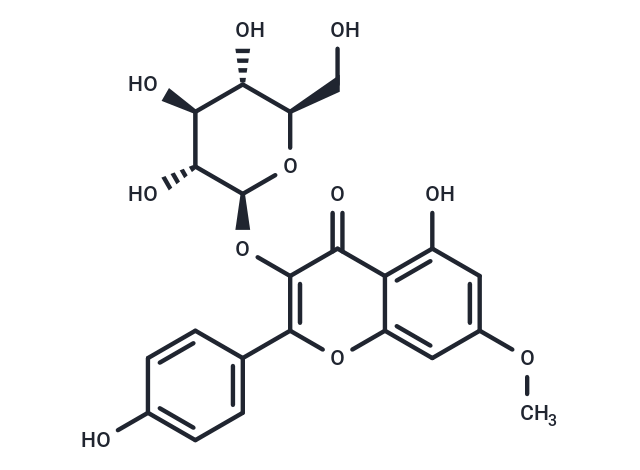Shopping Cart
- Remove All
 Your shopping cart is currently empty
Your shopping cart is currently empty

Rhamnocitrin 3-glucoside is a natural product for research related to life sciences. The catalog number is TN6505 and the CAS number is 41545-37-3.

| Pack Size | Price | Availability | Quantity |
|---|---|---|---|
| 10 mg | $700 | Backorder | |
| 1 mL x 10 mM (in DMSO) | $480 | Backorder |
| Description | Rhamnocitrin 3-glucoside is a natural product for research related to life sciences. The catalog number is TN6505 and the CAS number is 41545-37-3. |
| In vitro | Eleutherococcus sieboldianus (Makino) Koidz. is a local product from the area in and around Yonezawa City in Yamagata Prefecture, Japan. It has been used as a medicinal plant for a long time. METHODS AND RESULTS: We isolated and identified four types of flavonoid glycosides [astragalin (1), isoquercetin (2), rhamnocitrin 3-O-glucoside (Rhamnocitrin 3-glucoside, 3), and nicotiflorin (4)], a triterpene [methyl hederagenin (5)], and three types of triterpene glycosides [δ-hederin (6), echinocystic acid 3-O-arabinoside (7), and cauloside B (8)] from the methanol extract of E. sieboldianus, which regulates lipid accumulation in 3T3-L1 preadipocytes. Among the compounds isolated, 2 and 8 up- and down-regulated lipid accumulation and insulin induced adipocyte differentiation in 3T3-L1 preadipocytes. CONCLUSIONS: Compound 2 induced up-regulation of lipid accumulation and decreased adipocyte size, while 8 down-regulated lipid accumulations without decreasing cell size. Additionally, 2 increased adipogenic proteins [peroxisome proliferator-activated receptor γ (PPARγ), CCAAT/enhancer-binding protein alpha (C/EBPα), and fatty-acid-binding protein 4 (FABP4)]. In contrast, 8 decreased the levels of all adipogenic proteins and glucose transporter type 4 (GLUT4), but increased adiponectin. |
| Molecular Weight | 462.4 |
| Formula | C22H22O11 |
| Cas No. | 41545-37-3 |
| Relative Density. | no data available |
| Storage | Powder: -20°C for 3 years | In solvent: -80°C for 1 year | Shipping with blue ice. |

Copyright © 2015-2024 TargetMol Chemicals Inc. All Rights Reserved.